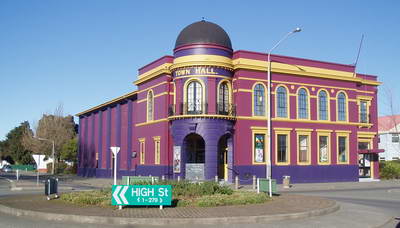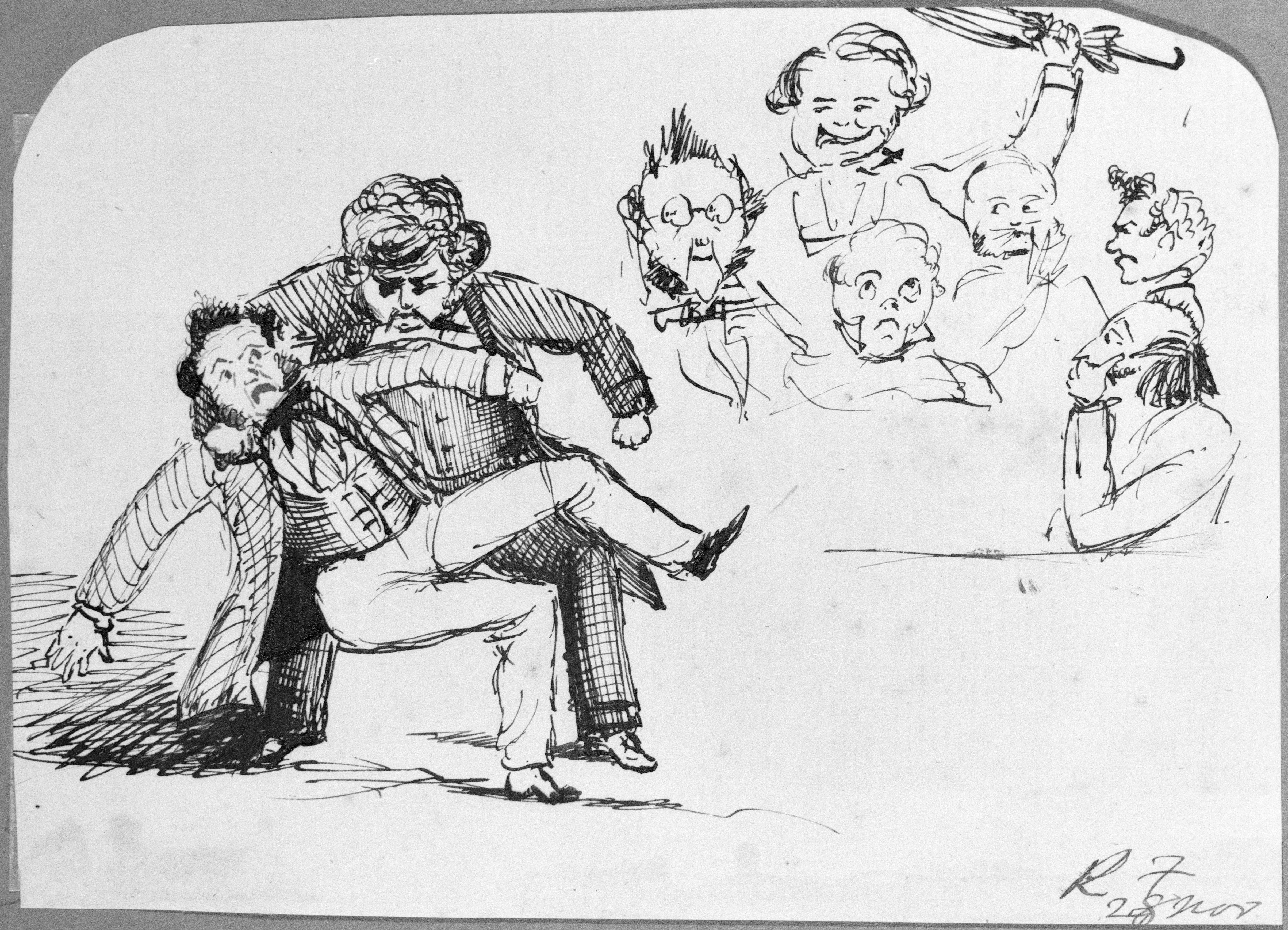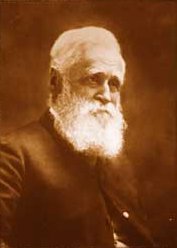|
Edward Jerningham Wakefield
Edward Jerningham Wakefield (25 June 1820 – 3 March 1879), known as Jerningham Wakefield, was the only son of Edward Gibbon Wakefield. As such, he was closely associated with his father's interest in colonisation. He worked for the New Zealand Company and later was a member of the Canterbury Association. He was active as a politician in New Zealand, both at national and provincial level, but became an alcoholic and died penniless in an old people's home. Early life Wakefield was born in London in 1820. His parents were Edward Gibbon Wakefield and Eliza Anne Frances Pattle, but his mother died within days of his birth. Together with his sister Nina, he was mostly brought up by Catherine Torlesse, his father's sister and mother of Charles Torlesse. Wakefield was known by his middle name and educated at Bruce Castle School and King's College London. Later life In 1839 he accompanied his uncle, Colonel William Wakefield to New Zealand on the New Zealand Company ship ''Tory''. ... [...More Info...] [...Related Items...] OR: [Wikipedia] [Google] [Baidu] |
Christchurch Country
Christchurch Country was a parliamentary electorate in the Canterbury region of New Zealand from 1853 to 1860. It was thus one of the original 24 electorates used for the 1st New Zealand Parliament. Geography The area covered by the Christchurch Country electorate was synonymous with the original area of Canterbury Province, i.e. covering all land from the east coast to the west coast of the South Island that lay north of Otago Province (covered by the electorate) and south of Nelson Province (covered by the electorate on the east coast; the west coast was virtually uninhibited by Europeans and initially not covered by an electorate). Thus, the Christchurch Country electorate extended from Awarua Point to the Grey River on the West Coast, and from the Waitaki River to the Hurunui River. Three settlements within Canterbury Province were covered by their own electorates, namely Town of Christchurch (covering an area now to be considered the central city), Town of Lyttelton ... [...More Info...] [...Related Items...] OR: [Wikipedia] [Google] [Baidu] |
Rangiora Bush, 6 December 1850
Rangiora is the largest town and seat of the Waimakariri District, in Canterbury, New Zealand. It is north of Christchurch, and is part of the Christchurch metropolitan area. With an estimated population of Rangiora is the 30th largest urban area in New Zealand, and the fifth-largest in the Canterbury region (behind Christchurch, Timaru, Ashburton and Rolleston). Geography Rangiora is north of Christchurch's Cathedral Square or 20 minutes drive north of the Christchurch International Airport. It is close to the northern end of Canterbury's Inland Scenic Route (formerly State Highway 72), which skirts the inner edge of the Canterbury Plains, running southwest to Timaru via Oxford and Geraldine. The Ashley River / Rakahuri is just to the north of the town. Climate Rangiora has an oceanic climate, (''Cfb'' according to the Köppen climate classification), with warm summers and mild winters. Rangiora has an average annual mean of , an average annual high of and an average ... [...More Info...] [...Related Items...] OR: [Wikipedia] [Google] [Baidu] |
The Press
''The Press'' is a daily newspaper published in Christchurch, New Zealand owned by media business Stuff Ltd. First published in 1861, the newspaper is the largest circulating daily in the South Island and publishes Monday to Saturday. One community newspaper—''Northern Outlook''- is also published by ''The Press'' and is free. The newspaper has won the title of New Zealand Newspaper of the Year (in its circulation category) three times: in 2006, 2007 and 2012. It has also won the overall Newspaper of the Year title twice: in 2006 and 2007. History James FitzGerald came to Lyttelton on the ''Charlotte Jane'' in December 1850, and was from January 1851 the first editor of the ''Lyttelton Times'', Canterbury's first newspaper. From 1853, he focussed on politics and withdrew from the ''Lyttelton Times''. After several years in England, he returned to Canterbury concerned about the proposed capital works programme of the provincial government, with his chief concern the pro ... [...More Info...] [...Related Items...] OR: [Wikipedia] [Google] [Baidu] |
1875–1876 New Zealand General Election
The 1875–1876 New Zealand general election was held between 20 December 1875 and 29 January 1876 to elect a total of 88 MPs in 73 electorates to the 6th session of the New Zealand Parliament. The Māori vote was held on 4 and 15 January 1876. A total of 56,471 voters were registered. Background Political parties had not been established yet; this only happened after the 1890 election. The previous parliament had 78 representatives from 72 electorates. In October 1875, Parliament passed the Representation Act 1875, and resolved to increase the size of Parliament to 88 representatives through the following changes: * one additional member for City of Dunedin (from two to three) * the single member electorates of Christchurch East and Christchurch West to amalgamate and form the City of Christchurch electorate with three members * one additional member for Timaru ( was formed as a new electorate) * one additional member for Waitaki (from one to two) * one additional member ... [...More Info...] [...Related Items...] OR: [Wikipedia] [Google] [Baidu] |
Wellington Province
Wellington Province, governed by the Wellington Provincial Council, was one of the provinces of New Zealand from 1853 until the abolition of provincial government in 1876. It covered much of the southern half of the North Island until November 1858, when Hawke's Bay Province split off, taking about a third of its area. Territory Wellington Province originally covered much of the southern half of the North Island. Its northern boundary was drawn arbitrarily across most of the middle of the island at latitude 39° south to the east coast, just including the entirety of Hawke Bay. North of that line was Auckland Province. The straight-line boundary did not extend right to the west coast, but dipped south to the coast just west of Waverley and short of Patea, allowing for New Plymouth Province (later renamed Taranaki Province) to the west. Hawke's Bay settlers broke away to form Hawke's Bay Province on 1 November 1858. Wellington Province's new eastern boundary followed the main d ... [...More Info...] [...Related Items...] OR: [Wikipedia] [Google] [Baidu] |
The Star (Christchurch)
''The Star'' is a newspaper published in Christchurch, New Zealand. It was published daily from 1868 to 1991. It became the ''Christchurch Star-Sun'' in June 1935 after merging with a rival newspaper, ''The Sun'', and at the time it ceased daily publication in 1991 it was known as ''The Christchurch Star''. It later became a free newspaper, published twice a week (on Wednesdays and Fridays) until 2016, then once a week (on Thursdays) since 2016. History The ''Star'' was first published on 14 May 1868 as the evening edition of the ''Lyttelton Times''. In April 2013 the ''Star'' was sold by APN New Zealand Media (owners of ''The New Zealand Herald'') to Mainland Media. Mainland Media was owned by Pier and Charlotte Smulders, and chaired by Nick Smith, the director of the Dunedin–based media company Allied Press. Smith had previously worked as an advertising cadet for ''The Star'' in 1965. In August 2018, Allied Press acquired ''The Star'' owners Star Media and its s ... [...More Info...] [...Related Items...] OR: [Wikipedia] [Google] [Baidu] |
Christchurch City East (New Zealand Electorate)
Christchurch East, originally called Christchurch City East, is a current New Zealand parliamentary electorate. It was first created for the and was abolished for two period, from 1875–1905 and again from 1946–1996. It was last created for the introduction of the MMP voting system for the . The current MP is Poto Williams, a member of the New Zealand Labour Party who was first elected in the 2013 Christchurch East by-election. Population centres The electorate is based on the eastern part of the City of Christchurch. When the electorate was first formed through the Representation Act 1870, the western boundary of the electorate was Colombo Street. Unlike today, the eastern boundary was away from the coast; rather, the electorate covered the coastal regions. The electorate is bounded in the east by the Pacific Ocean and in the north by the Waimakariri River. Since the 2008 election, the western and southern boundary followed Main North Road, Marshland Road, North Parade, ... [...More Info...] [...Related Items...] OR: [Wikipedia] [Google] [Baidu] |
5th New Zealand Parliament
The fifth New Zealand Parliament was a term of the New Zealand Parliament. Elections for this term were held in 68 European electorates between 14 January and 23 February 1871. Elections in the four Māori electorates were held on 1 and 15 January 1871. A total of 78 MPs were elected. Parliament was prorogued in December 1875. During the term of this Parliament, six Ministries were in power. Sessions The fifth Parliament opened on 14 August 1871, following the 1871 general election. It sat for five sessions, and was prorogued on 6 December 1875. Historical context Political parties had not been established yet; this only happened after the 1890 election. Anyone attempting to form an administration thus had to win support directly from individual MPs. This made first forming, and then retaining a government difficult and challenging. Ministries Since June 1869, the third Fox Ministry was in power, led by Premier William Fox. On 10 September 1872, the third Stafford Min ... [...More Info...] [...Related Items...] OR: [Wikipedia] [Google] [Baidu] |
1st New Zealand Parliament
The 1st New Zealand Parliament was a term of the Parliament of New Zealand. It opened on 24 May 1854, following New Zealand's first general election (held the previous year). It was dissolved on 15 September 1855 in preparation for that year's election. 37 Members of the House of Representatives (MHRs) represented 24 electorates. Parliamentary sessions The Parliament sat for three sessions: New Zealand had not yet obtained responsible government (that is, the power to manage its own affairs), and so the 1st Parliament did not hold any significant power. The 1st Parliament was held before the creation of either political parties or the office of Premier. There were, however, appointments made to the Executive Council (the formal institution upon which Cabinet is based). From 14 June 1854 to 2 August 1854, there was a four-person cabinet, New Zealand's first ministry, led by James FitzGerald, with Henry Sewell, Frederick Weld, and Thomas Bartley (a fifth member, Dillon ... [...More Info...] [...Related Items...] OR: [Wikipedia] [Google] [Baidu] |
1871 New Zealand General Election
The 1871 New Zealand general election was held between 14 January and 23 February to elect 78 MPs across 72 electorates to the fifth session of the New Zealand Parliament. 41,527 electors were registered. Background 1871 was the first general election to include the four Māori electorates, with elections held on 1 and 15 February. The first Māori Members of Parliament had been elected in 1868, but in 1871 three retired and one (Western Maori) was defeated. So in 1871 four new Māori MPs were elected. In 1866 the secret ballot was introduced for general (European) elections. The 1871 general election was the first one at which it was used. The secret ballot not used in Māori electorates until 1938, thus Māori voters continued to inform a polling officer orally of their chosen candidate. The date of election is defined here as the day on which the poll took place, or if there was no contest, the day of nomination. The earliest election day was 14 January 1871. The earliest da ... [...More Info...] [...Related Items...] OR: [Wikipedia] [Google] [Baidu] |
1853 New Zealand General Election
The 1853 New Zealand general election was a nationwide vote to determine the shape of the New Zealand Parliament's 1st term. It was the first national election ever held in New Zealand, although Parliament did not yet have full authority to govern the colony, which was part of the British Empire at that time. Elections for the first provincial councils and their Superintendents were held at the same time. Background The New Zealand Constitution Act 1852, passed by the Parliament of the United Kingdom, established a bicameral New Zealand Parliament, with the lower house (the House of Representatives) being elected by popular vote. Votes were to be cast under a simple FPP system, and the secret ballot had not yet been introduced. To qualify as a voter, one needed to be male, to be a British subject, to be at least 21 years old, to own a certain value of land, and to not be serving a criminal sentence. One of the candidates elected (on 27 August, for Christchurch Country) was a l ... [...More Info...] [...Related Items...] OR: [Wikipedia] [Google] [Baidu] |
Barnet Burns
Barnet Burns (November 1805 – 26 December 1860) was an English sailor, Merchant, trader, and showman who became one of the first Europeans to live as a Pākehā Māori and to receive the Tā moko, full Māori facial tattoo. He travelled to Australia and found employment as a trader of phormium, flax in New Zealand in the 1830s. Burns returned to Europe in 1835 and spent most of his remaining years as a showman giving lectures, where he described the customs of the Māori, performed the haka, exhibited his Māori people, Māori tattoos and recounted his adventures in New Zealand. Early life It is likely that George Burns, later known as Barnet, was baptised in the parish of Kirkby Ireleth on 25 November 1805. His parents were likely George Burns (born 1770) and Anne (née Stewart).Registers of the Parish Church of Kirkby Ireleth 1681 - 1812, page 57, published Lancashire Parish Register Society, 1911. At the age of 13 or 14 he became a cabin boy and ended up working for Louis Ce ... [...More Info...] [...Related Items...] OR: [Wikipedia] [Google] [Baidu] |







